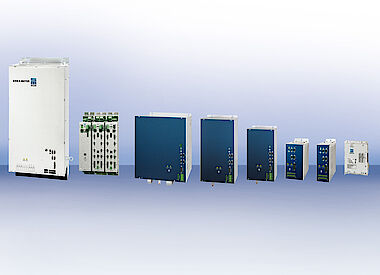Keep Cool: High-speed Frequency Converters by SIEB & MEYER
Technical papers
Prevent Motor Heating at the Outset
The frequency converters of series SD2x and SD4x by SIEB & MEYER specialize in operating high-speed motors, which allow only low motor losses. The solutions of the Lueneburg based company are perfectly adapted to this requirement: with the use of SIEB & MEYER solutions, converter-based motor losses are significantly reduced compared to competitive products. Beside the lower motor heating, the system efficiency is increased and power consumption is reduced. This in turn has positive effects on the manufacturing quality and saves costs – a win-win situation for the user who can indeed keep "cool".
"About 90% of all losses caused by the converter occur in the rotor. These losses result in heat that can damage the motor", Torsten Blankenburg, CEO at SIEB & MEYER, explained. "Taking into account the small rotor volume as a design-specific factor of high-speed motors, further temperature problems are the outcome." A danger foreseen is half avoided: The SD2x frequency converter family by SIEB & MEYER comes with control techniques that ensure a small proportion of harmonic frequencies in the motor current. Losses are up to 90 % lower compared to competitive products; the heating of the motor is reduced correspondingly. Other advantages of the low motor heating are a longer service life of ball bearings and positive effects on the manufacturing quality.
Improving the quality of motor currents
What exactly are the backgrounds and how can we improve the quality of the motor currents? "To answer this question, it is important to know that all currents that differ from the ideal sinus curve, produce losses in the motor", Torsten Blankenburg explained. "This part of the motor current is generated by the converter and is called ripple current. The ripple current overlays the sinusoidal motor current." The generated ripple current depends on the switching frequency, the DC voltage of the converter and – most crucial – the motor inductance. Small inductances cause great ripple currents: This is especially problematic with high-speed synchronous motors, as they have small inductances because of their physics. The generated rotor heat can have a great impact on rotor stability, permanent magnets and bearings. These problems occur especially at high rated currents of the motors.
To avoid them, standard converters with two-level pulse-PWM and low switching frequency are often used in combination with LC filters. These solutions are individual combinations of passive electronic components that either smooth the switching edges of the pulse pattern supplied by the converter (dV/dt filter) or even provide almost sinusoidal motor voltages and currents. Using LC filters, however, means additional costs, additional installation space and weight as well as losses in efficiency. Apart from that, the LC filter must be dimensioned for the individual application in advance, which is time-consuming and requires flexibility.
Three-level technology in combination with higher switching frequencies
Another potential solution, however, is to increase the switching frequency for PWM. Doubling the switching frequency reduces the ripple current usually by half. There are technical as well as economical limits to this solution, though. For one thing, fast switching power transistors are more expensive for higher voltage ranges. In addition, the switching losses in the output stage increase drastically, which has a very unfavourable effect on the efficiency and thus also on the cooling effort. Apart from that, not all motors can cope well with increased switching frequencies. With some constructions, increasing the switching frequency hardly reduces the motor losses. This is often the case with synchronous motors using permanent magnets without segmentation.
An alternative solution is the use of the three-level technology, which for example the frequency converter SD2M is based on. Compared to two-level technology, only half the voltage is supplied to the power semiconductors of the output stages. This makes the use of power semiconductor designed for much lower voltages possible. Better yet, these semiconductors can switch faster (for technological reasons). The result: There are fewer switching losses in the output stage, which enables significantly higher switching frequencies. In addition, the motor is loaded with only 50 % of the voltage jumps compared to two-level technology. The use of three-level technology alone, can reduce the losses generated in the rotor by about 75 %. Three-level technology in combination with higher switching frequencies can reduce the losses by up to 90 %. LC filters can then often be omitted.
Good, better, cool: A new device generation on the rise
So far so good – and it gets even better: SIEB & MEYER has recently presented the new development platform SD4x, the basis for a development of a sustainable device series. The devices support new interfaces and offer a number of additional functions. Users will benefit from higher speeds and from a significantly enhanced performance. Thanks to an integrated position controller, SD4x devices can now execute high-precise positionings. The speed and current controller have remained unchanged with regard to the SD2x series. "Our aim is to drive high-speed motors dynamically and with even less power losses", said Blankenburg. Therefore, we now support PWM switching frequencies of 24 and 32 kHz." For an even finer modulation of the sine-wave signal, we have integrated a commutation angle control for 32, 48 and 64 kHz. The result is an almost optimum sine with nearly no harmonic currents. The power loss caused by the PWM can be reduced to a small fraction.
"The optimized performance, higher speeds as well as the lower motor heating without sine-wave filter – these are substantial advantages of the SD4x product family", summarized Blankenburg. The enhancements will allow improving the production quality for existing applications and, beyond that, exploring completely new fields of application."Conclusion: No matter which generation – with frequency converters by SIEB & MEYER users can freeze off motor heating in any case.